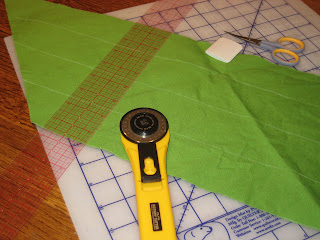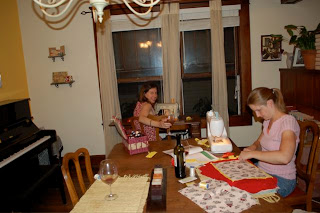 I don't really think it's quite sunk in yet. Feels almost a bit miraculous. This project has been dang close to finished for SO many months. Extreme silliness. This was my very first sewing project - had several lessons from a wonderfully experienced sewing guru in the neighborhood and this is what I chose to learn with - she showed me how to read the patterns, mark and cut the fabric, gather the corners, sew on the bias tape, and so, so much more. It was great! Then, somehow with projects of all sorts popping up all over the place, it fell to the wayside. Now, everytime I've been in the craft room for the past several months, the mostly finished machine cover would get a pained glance followed by feelings of regret and determination to one day finish - and always with a sooner than later plan, especially on the days where the machine actually seemed most unfortunately and quite avoidably dusty.
I don't really think it's quite sunk in yet. Feels almost a bit miraculous. This project has been dang close to finished for SO many months. Extreme silliness. This was my very first sewing project - had several lessons from a wonderfully experienced sewing guru in the neighborhood and this is what I chose to learn with - she showed me how to read the patterns, mark and cut the fabric, gather the corners, sew on the bias tape, and so, so much more. It was great! Then, somehow with projects of all sorts popping up all over the place, it fell to the wayside. Now, everytime I've been in the craft room for the past several months, the mostly finished machine cover would get a pained glance followed by feelings of regret and determination to one day finish - and always with a sooner than later plan, especially on the days where the machine actually seemed most unfortunately and quite avoidably dusty.So, now it's complete... ahhh. It only needs a quick final pressing just to finish it off and make it hang better. I really, really love it and had to take a pic asap to proudly show it off. Funny thing - I go in to take a photo and the battery is dead; camera shuts off; so, I go swap the battery pack and turn it back on; that battery is also dead - damn! so, I eject the battery, try turning it back on and quickly switch off the display to the screen and manage to eek out one last picture before the camera again shuts off with a message insisting that I replace the battery with one having charge. I count this eek out as a victory and load the photos with plans to do the posting on my lunch break tomorrow, but I'm still so excited to be finished with this project that I couldn't resist starting the post right away. ha! so not like me, really. Anyway, I will finish tomorrow with talk of the new bias tape making method that is super cool and much faster than the way I did it before.
Ok, so this method is actually from one of the packets Ms. Peggy Sue brought for me on a sewing lesson day. It explains how to make a continuous piece of bias tape, which I've read before, but just didn't really get it until this past Saturday.
First of all, the way I did it one other time was to cut sections of fabric wide enough for a double fold, but then ending up with a stack of bias tape segments needing to be joined. VERY long process. ugh! Plus, last time I did not actually make "bias tape" - it is simply "binding" unless you cut it on the bias, which means that is is diagonal to the selvage edge. Cutting something on the bias gives it some strength and stretch and allows it to move and hang better - it is most always used when making clothing or edging anything with a curve. I read that it's not really necessary to cut on the bias when edging something flat with straight 90 degree corners such as a kitchen towel - it annoys some people that you will tend to waste some fabric since you're marking on a diagonal and start with the first full strip between selvages for a continuous strip, thus discarding the excess on the ends. (Note: That last sentence to may not make much sense until the end of this little walk-through.)
 Ok, so the first thing you do is mark the strips on the diagonal to the selvage. The easiest way to do this is to fold the fabric from one corner at the end of the selvage over to the other selvage side. This creates a 45 degree angle to guide the marking. I wanted 1/2" double-fold bias tape, so marked strips in 2" segments. Before marking, measure the edges of the kitchen towel that will be bound with the bias tape to figure out how long the continuous strip will need to be. After measuring the length of one strip, I figured that I would need a total of four long bias strips to make up the entire continuous length.
Ok, so the first thing you do is mark the strips on the diagonal to the selvage. The easiest way to do this is to fold the fabric from one corner at the end of the selvage over to the other selvage side. This creates a 45 degree angle to guide the marking. I wanted 1/2" double-fold bias tape, so marked strips in 2" segments. Before marking, measure the edges of the kitchen towel that will be bound with the bias tape to figure out how long the continuous strip will need to be. After measuring the length of one strip, I figured that I would need a total of four long bias strips to make up the entire continuous length. Now, for the fun part. So, you mark the strips, then cut off the excess (triangles on either side of the angled strips), then also cut 1/4" off each selvage edge (short strip ends) just to tidy up. This gets you to the photo above.
Now, for the fun part. So, you mark the strips, then cut off the excess (triangles on either side of the angled strips), then also cut 1/4" off each selvage edge (short strip ends) just to tidy up. This gets you to the photo above.Next, you match up the short ends of the strips with right sides facing (or markings on the outside). Arrange them so one strip overlaps at each end - so they're offset by one strip width - and pin. The photo doesn't show it too well, so if it's not clear yet, hopefully it will be after the next step.
 So, the whole point of the overlapping strips is to create a spiral of sorts. Once happy with the way the short strip edges are lined up, sew a 1/4" seam on this edge and press the seam open. Now, if you start at either end and cut following the line markings, you will cut in a spiral pattern creating one very long piece of 2" bias strip. When cutting over the seam, just focus on getting from the end of one mark cross-wise to the beginning of the next mark - it's a little awkward that it doesn't seem straight across the seam after sewing and pressing open, but I promise it turns out perfectly fine once you cut the long piece and press in the foldings.
So, the whole point of the overlapping strips is to create a spiral of sorts. Once happy with the way the short strip edges are lined up, sew a 1/4" seam on this edge and press the seam open. Now, if you start at either end and cut following the line markings, you will cut in a spiral pattern creating one very long piece of 2" bias strip. When cutting over the seam, just focus on getting from the end of one mark cross-wise to the beginning of the next mark - it's a little awkward that it doesn't seem straight across the seam after sewing and pressing open, but I promise it turns out perfectly fine once you cut the long piece and press in the foldings.The last part takes some practice and some patience, but basically you have your iron set on the hottest setting for the fabric you're using and pull the strip(s) slowly while pressing on the folded end as it comes through. You can either use a bias tape making tool or I've just been marking the right width and setting up a makeshift tool with a long, straight pin on the ironing board. This first fold has each side tucked inward to meet in the center.
 From time to time, the folds start to get off (uneven) and you just have to set down the iron, pull it backward a bit, straighten the fold with your fingers, then start pulling through and pressing the fold again. Once the entire strip length is pressed once, press the last fold by just halving once more. See last pic of finished product wrapped around another package of the store-bought stuff.
From time to time, the folds start to get off (uneven) and you just have to set down the iron, pull it backward a bit, straighten the fold with your fingers, then start pulling through and pressing the fold again. Once the entire strip length is pressed once, press the last fold by just halving once more. See last pic of finished product wrapped around another package of the store-bought stuff. Now, it's ready to apply. I won't post those general bias tape instructions here, since I don't have pics to go with, but the Posie Gets Cozy blog has this tutorial I learned from and she even gives clear instructions for mitering the corners.
Now, it's ready to apply. I won't post those general bias tape instructions here, since I don't have pics to go with, but the Posie Gets Cozy blog has this tutorial I learned from and she even gives clear instructions for mitering the corners.Maybe the bound and finished kitchen towel will make it into a future post - I'll try and remember to do that.








